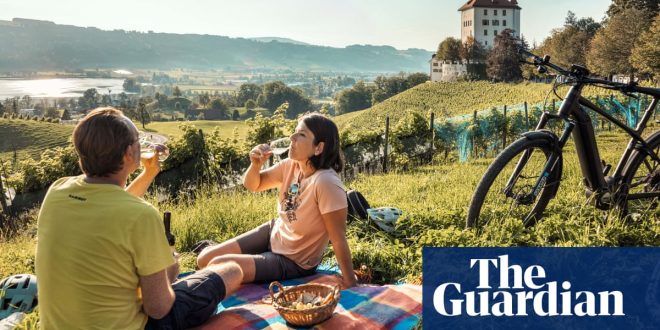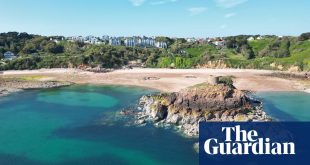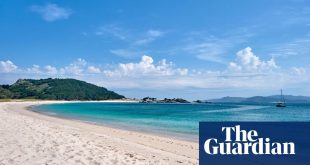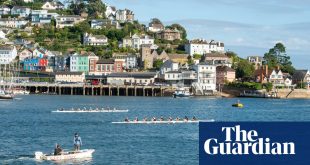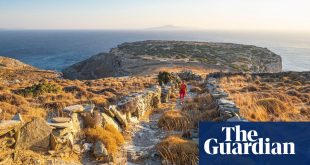With relatively few cars and roads as smooth as a Federer serve, Switzerland seems engineered for a low-carbon cycling holiday. Indeed, the Swiss government has launched a number of new cycle routes in recent years – including cycle route 1291.
Named after Switzerland’s founding year, route 1291 wraps around the heart of old Switzerland: the three founding cantons of Unterwalden (now Obwalden and Nidwalden), Uri, and Schwyz, as well as Lucerne. Starting and ending in the city of Lucerne, it runs through picturesque countryside for 240 miles. Sounds dreamy, but there’s just one problem: those mountains.
Thankfully, the invention of the electric bicycle means that more of us can strap on a metaphorical extra pair of quadriceps, divert our minds from the climb and on to the Alpine views. They’ve surged in popularity: almost half of all new bikes sold in Switzerland are now ebikes.
I’ve come to sample an 111-mile section of route 1291 (the Lucerne canton part). I start by catching a train from Lucerne to Schüpfheim, then the 241 bus to Sörenberg. There, I pick up my rental bike – a sturdy, touring-style ebike made for long distances and heavy loads – along with my guide, Céline Deplazes from Lucerne Tourism. We’ll be following an itinerary designed by Eurotrek, which is typically self-guided with luggage, thankfully, shuttled from one hotel to the next.
Céline tells me that Route 1291, which was launched in 2022, was created in part to tempt travellers away from the overcrowded city of Lucerne and into the wider region. This includes Entlebuch, a Unesco biosphere of moorlands and serrated peaks up to 1,910 metres that will be the focus of our first day’s cycling.
I get off to a rough start. The sky is spitting rain, and on the only offroad section of the entire trip – a downhill stretch of farming track just 2.5 miles long – my tyre skids, the mountains spin and I tumble on to the wet gravel, cutting my knee. As she helps to patch me up, Céline agrees that this section is probably better walked.
It’s the only bump; the rest of the way is paved with Swiss precision. I spend most of the ride with my bike in the low-powered “eco” mode, occasionally flipping to “standard” and once to “high” on a steep hill. There are charging stations at most restaurants we stop at, though I never use them – the overnight charge at the hotel is enough.
In fact, the only real danger Switzerland poses to cyclists lies in its pulchritude – scenes so absorbing that you risk taking your eyes off the road and careering off a cliff. Overhead is the celestial karst ridge of Schrattenfluh, flocked with conifers; before me are those chalet-like homes, their wooden walls looking like slabs of chocolate with piped-on pink geranium window boxes. The passage of my bike scatters a perfume of damp heather and alpine bellflowers. And of course, everywhere are those chestnut-brown cows, the jangle of their bells ringing out like the peals from a church tower.
Despite electrical assistance, ebiking still works up an appetite. At the Marbach Alpine dairy, we gorge on a platter heaped with Heukäse (cow’s cheese aged in hay), buffalo mozzarella and another buffalo cheese studded with tangy fenugreek seeds.
Marbach was the first dairy in Switzerland to process buffalo milk – which comes from Bruno Renggli’s farm, a mile north. We smell it before we see it: the earthy musk of dung and cut grass.
Bruno imported his herd from Romania in 1996, after a drop in the price of cow’s milk. Buffalo milk has a higher fat and protein content (yet less cholesterol), and costs four times as much.
“They rarely get stressed,” he says – gesturing to one of his herd, who is appraising us from her mud bath. “So the taste of the milk is unaffected. Don’t stress yourself – it’s not healthy.”
after newsletter promotion
After overnighting in one of several pretty, whitewashed apartments in Entlebuch village, we leave the mountains for the low, green hills of the Napf region. Sunlight has banished yesterday’s clouds, spilling through the gaps between spruces as we follow the path of a stream.
Fittingly, the best-known sweet treat in Lucerne canton is the Willisauer Ringli, created in 1850 at Café Amrein in Willisau, where we make our next stop.
“It’s the hardest cookie you can get in Switzerland,” says Michael Renggli, the cafe’s fourth-generation owner, holding one of the ring-shaped biscuits in his palm. The idea is not to chew, but to suck them like hard-boiled sweets (the recipe contains more than 50% sugar). Lemon and orange zest prickle my tongue, followed by the heat of the family’s secret spice blend.
Fuelled by sucrose, I zoom along the last nine miles to Hotel Sursee in the town of the same name, on the banks of the Sempachersee.
The final day is mostly a relaxed downhill roll, around the northern shore of the Baldeggersee and into Swiss wine country. On a south-facing hill knotted with vines, we come to 800-year-old Heidegg Castle, its ivory walls jewelled with little pink roses. Once a bastion of aristocracy, it was donated to the canton of Lucerne in 1950 after its owners – two sisters from the once-powerful Pfyffer family – ran into financial problems. After a guided tour, we get a taste of the wine collection, made from the castle’s 70-year-old vines: a honeysuckle-scented riesling, a raspberry-ish rosé and a jammy pinot noir.
The last 23 miles feel a little hairy – having had the road almost to ourselves, I resent rejoining the traffic. When I arrive back in Lucerne, it is as postcard-perfect as ever: the medieval apartments mirrored in the Reuss River, which is crossed by the Chapel Bridge, with its vaulted wooden roof. But right now, the buses, chocolate shops and tourists are all too much; I long to be back in the wilds of the canton, where the only stressor was deciding which cheese to eat.
The trip was provided by Switzerland Tourism and Lucerne Tourism, with travel pass provided by the Switzerland Travel Centre. Self-guided tours on Route 1291 with Eurotrek cost from CHF1,444 (£1,287) including ebike hire, six nights’ B&B accommodation and luggage transfers. Independent travellers can hire bikes from Rent a Bike and download maps from the Route 1291 website
 Top Naija News – Nigeria News, Nigerian News & Top Stories Top Naija News – Nigerian Newspapers, Nigerian News. topnaijanews is a daily Nigerian newspaper covering Latest News, Breaking News, Entertainment, Sports, Lifestyle and Politics.
Top Naija News – Nigeria News, Nigerian News & Top Stories Top Naija News – Nigerian Newspapers, Nigerian News. topnaijanews is a daily Nigerian newspaper covering Latest News, Breaking News, Entertainment, Sports, Lifestyle and Politics.
